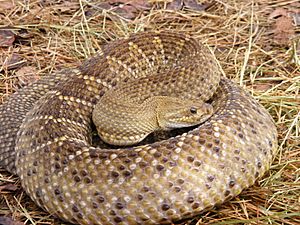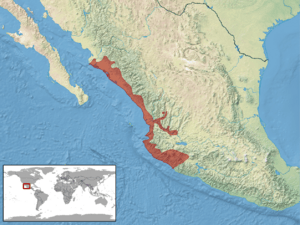Mexican west coast rattlesnake facts for kids
Quick facts for kids Mexican west coast rattlesnake |
|
|---|---|
 |
|
| Conservation status | |
| Scientific classification | |
| Genus: |
Crotalus
|
| Species: |
basiliscus
|
 |
|
| Synonyms | |
The Mexican West Coast Rattlesnake (scientific name: Crotalus basiliscus) is a type of venomous snake. It is also known as the "Mexican Green Rattler." This snake is a kind of pit viper. Its scientific name, basiliscus, comes from a Greek word meaning 'King'. This name was given because of the snake's large size and powerful venom. There are no different types (subspecies) of this snake known today.
Contents
About the Mexican West Coast Rattlesnake
The Mexican West Coast Rattlesnake is one of the biggest rattlesnake species. Many of these snakes can grow to be about 150 centimeters (4.9 feet) long. The longest one ever found was about 204.5 centimeters (6.71 feet) long! When they are young, these snakes are mostly red. But as they grow into adults, their color changes to olive green or a yellowish cream.
Where This Rattlesnake Lives
These snakes live in western Mexico. You can find them from the southern part of Sonora all the way to Michoacán. They prefer places that do not have many trees. Instead, they live in areas covered with short grass, thorny bushes, and lots of cactus.
What the Mexican West Coast Rattlesnake Eats
Scientists do not know everything about what this rattlesnake eats. However, they have found hair from mammals inside seven Mexican West Coast Rattlesnakes. This hair likely came from small rodents, which are probably a main part of their diet.
How This Rattlesnake Behaves
In warmer, lower areas, these snakes are most active during the rainy summer months. People have seen them crossing roads at night. Sometimes, they are also seen basking in the sun early in the morning. This helps them warm up. It has been noted that Mexican West Coast Rattlesnakes can become quite calm when they live in zoos.
Images for kids
-
C. basiliscus at Wilmington Serpentarium in North Carolina, United States
See also
 In Spanish: Serpiente de cascabel de la costa oeste de México para niños
In Spanish: Serpiente de cascabel de la costa oeste de México para niños



